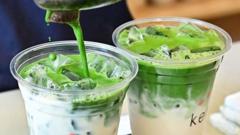Matcha, the vibrant green tea originating from Japan, is experiencing an unprecedented surge in popularity across the globe. This phenomenon, often termed "matcha mania," finds its way into various products from Starbucks lattes in the UK to Krispy Kreme doughnuts in Singapore. The trend is significantly propelled by social media influencers, who share brewing methods, recipes, and reviews, leading to the viral “Matcha Tok” hashtag, amassing millions of views online.
As matcha continues to gain traction, particularly with the boom in tourism to Japan, the demand for this finely ground green tea has skyrocketed. With Japan's currency remaining weak post-pandemic, both the country and its products have become highly attractive to international tourists. According to Lauren Purvis, a US-based tea importer, this insatiable demand is causing once-monthly supplies of matcha to dwindle in mere days, with some cafes reportedly requesting a kilo daily to meet their customer demands.
However, this growing appetite for matcha is met with challenges. Record heatwaves have negatively impacted tea crop yields, particularly in Kyoto—a key region for matcha cultivation. The aging farmer demographic is exacerbating the situation, as younger generations increasingly shy away from agricultural careers. Many popular matcha shops in Uji, a city renowned for its matcha production, often find their shelves quickly emptied by enthusiastic visitors. Consequently, retailers are resorting to purchase limits, and the prices of matcha have increased by approximately 30% at some establishments.
Advocates for mindful consumption are voicing concerns regarding the trend of hoarding and reselling matcha, emphasizing that matcha should not merely be seen as an ingredient for extravagant food dishes but appreciated for its unique qualities. The Global Japanese Tea Association recommends utilizing lower-grade matchas for cooking, reserving higher-quality options for traditional consumption, promoting a deeper respect for the cultural significance of the tea.
Moreover, the imposition of US tariffs on Japanese goods threatens to further inflate the prices of matcha, with potential additional hikes on the horizon. As trade discussions continue and tariffs loom, supply chain stakeholders like Purvis are preparing for the repercussions, urging the recognition of specialty tea’s uniqueness and the need for exemption from tariffs.
In an optimistic note amidst the challenges, some like Masahiro Nagata from Matcha Tokyo express hope that the market may stabilize in the next few years as current consumption trends eventually level off. Matcha, rich in history and health benefits, stands at a crossroads where its surge in popularity could either secure its future or lead to a concerning decline in traditional practices.




















